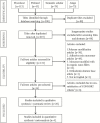Monomer Modifications of Denture Base Acrylic Resin: A Systematic Review and Meta-analysis
- PMID: 31198322
- PMCID: PMC6555369
- DOI: 10.4103/JPBS.JPBS_34_19
Monomer Modifications of Denture Base Acrylic Resin: A Systematic Review and Meta-analysis
Abstract
Background: Methyl methacrylate monomer of denture base resins was modified with several monomers to achieve better physico-mechanical properties without compromising the biocompatibility. However, there are no consensuses on the best strategy to achieve best modified monomer.
Purpose: To identify and evaluate the differences in the properties between conventional and modified monomers and to verify the influence of several variables on the properties of denture base acrylic resin.
Materials and methods: This study was executed by following the Preferred Reporting Items for Systematic Reviews and Meta-Analyses statement. In-vitro studies that investigated the properties of conventional and modified monomers were selected. Searches were carried out in the Ebscohost, PubMed, Semantic scholar and J-stage databases. The search commenced from the year 1995 and the last search was done till November 2018. A comparison was performed between modified and unmodified monomers. The analyses were carried out using fixed-effect models.
Results: The meta-analysis results showed high heterogeneity in all aspects, and higher flexural strength for monomers modified with 20% methacrylic acid.
Conclusion: Although the articles included in this meta-analysis showed high heterogeneity and high risk of bias, the in-vitro literature seems to suggest that use of modified monomers could improve the properties of denture base resins. Other variants of monomer modifications and their tested parameters were discussed in this systematic review as well. Dimensional accuracy is an unexplored variable to be evaluated extensively in the future researches.
Keywords: Methyl-methacrylate; Monomer; biocompatibility; properties.
Conflict of interest statement
There are no conflicts of interest.
Figures
Similar articles
-
Effect of silicon dioxide nanoparticles on the flexural strength of heat-polymerized acrylic denture base material: A systematic review and meta-analysis.Saudi Dent J. 2021 Dec;33(8):775-783. doi: 10.1016/j.sdentj.2021.08.008. Epub 2021 Aug 28. Saudi Dent J. 2021. PMID: 34938017 Free PMC article. Review.
-
Flexural strength and moduli of hypoallergenic denture base materials.J Prosthet Dent. 2005 Apr;93(4):372-7. doi: 10.1016/j.prosdent.2005.01.011. J Prosthet Dent. 2005. PMID: 15798688
-
Hydrophobicity of Denture Base Resins: A Systematic Review and Meta-analysis.J Int Soc Prev Community Dent. 2022 Apr 8;12(2):139-159. doi: 10.4103/jispcd.JISPCD_213_21. eCollection 2022 Mar-Apr. J Int Soc Prev Community Dent. 2022. PMID: 35462737 Free PMC article. Review.
-
Effect of repair resin type and surface treatment on the repair strength of heat-polymerized denture base resin.J Prosthet Dent. 2014 Jan;111(1):71-8. doi: 10.1016/j.prosdent.2013.09.007. Epub 2013 Oct 22. J Prosthet Dent. 2014. PMID: 24161257
-
Bond strength of soft liners to denture base resins and the influence of different surface treatments and thermocycling: A systematic review.J Prosthet Dent. 2020 Jun;123(6):800-806.e6. doi: 10.1016/j.prosdent.2019.06.013. Epub 2019 Nov 5. J Prosthet Dent. 2020. PMID: 31703921
Cited by
-
Effect of Novel Cycloaliphatic Comonomer Incorporation on the Color Stability of Thermo-polymerized Denture Base Resin.J Pharm Bioallied Sci. 2021 Nov;13(Suppl 2):S1131-S1135. doi: 10.4103/jpbs.jpbs_202_21. Epub 2021 Nov 10. J Pharm Bioallied Sci. 2021. PMID: 35017944 Free PMC article.
-
Copolymerization of Ring-Opening Oxaspiro Comonomer with Denture Base Acrylic Resin by Free-Radical/Cationic Hybrid Polymerization.J Pharm Bioallied Sci. 2021 Jun;13(Suppl 1):S527-S531. doi: 10.4103/jpbs.JPBS_582_20. Epub 2021 Jun 5. J Pharm Bioallied Sci. 2021. PMID: 34447147 Free PMC article.
-
On the Addition of Multifunctional Methacrylate Monomers to an Acrylic-Based Infusible Resin for the Weldability of Acrylic-Based Glass Fibre Composites.Polymers (Basel). 2023 Feb 28;15(5):1250. doi: 10.3390/polym15051250. Polymers (Basel). 2023. PMID: 36904491 Free PMC article.
-
Effect of zirconia nanoparticles in heat-cured acrylic resins on bacterial adhesion in vegan beverages.Appl Microbiol Biotechnol. 2025 Mar 25;109(1):76. doi: 10.1007/s00253-025-13457-7. Appl Microbiol Biotechnol. 2025. PMID: 40131518 Free PMC article.
-
Synthesis and Characterization of a Ring-Opening Oxaspiro Comonomer by a Novel Catalytic Method for Denture Base Resins.J Pharm Bioallied Sci. 2021 Jun;13(Suppl 1):S521-S526. doi: 10.4103/jpbs.JPBS_524_20. Epub 2021 Jun 5. J Pharm Bioallied Sci. 2021. PMID: 34447146 Free PMC article.
References
-
- al-Mulla MA, Murphy WM, Huggett R, Brooks SC. Effect of water and artificial saliva on mechanical properties of some denture-base materials. Dent Mater. 1989;5:399–402. - PubMed
-
- Anderson GC, Schulte JK, Arnold TG. Dimensional stability of injection and conventional processing of denture base acrylic resin. J Prosthet Dent. 1988;60:394–8. - PubMed
-
- Anthony DH, Peyton FA. Evaluating dimensional accuracy of denture bases with a modified comparator. J Prosthet Dent. 1959;9:683–92.
-
- Anthony DH, Peyton FA. Dimensional accuracy of various denture-base materials. J Prosthet Dent. 1962;12:67–81.
-
- Rodriguez LS, Paleari AG, Giro G, de Oliveira Junior NM, Pero AC, Compagnoni MA. Chemical characterization and flexural strength of a denture base acrylic resin with monomer 2-tert-butylaminoethyl methacrylate. J Prosthodont. 2013;22:292–7. - PubMed



